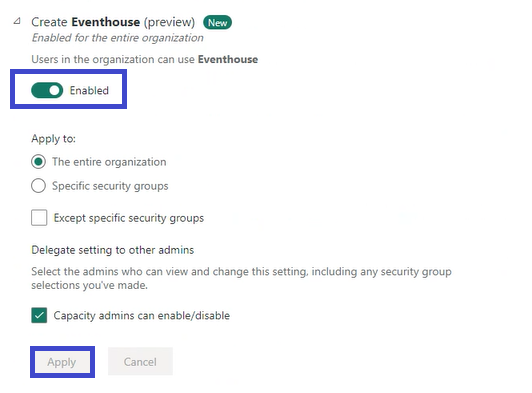Eventhouse: The Real-Time Analytics in Microsoft Fabric
- The Tech Platform

- Mar 13, 2024
- 3 min read
In real-time data analysis and management, Microsoft Fabric stands as a powerful platform offering a suite of tools and services. Among these, the Eventhouse feature plays a pivotal role. This article aims to provide an in-depth understanding of Eventhouse, its functionalities, capabilities, and how it can be effectively utilized in various scenarios. We will also guide you through the steps to create and manage an Eventhouse in Microsoft Fabric, helping you unlock its full potential for your data analysis needs.
Stay tuned!
Introduction to Eventhouse in Microsoft Fabric
An Eventhouse is a dynamic workspace within Microsoft Fabric designed to handle and analyze large volumes of real-time data. It hosts multiple KQL databases as part of Fabric Real-Time Analytics, making it a powerful tool for managing event-based data such as telemetry and log data, time series and IoT data, security and compliance logs, or financial records.
Eventhouse was introduced as a part of Microsoft Fabric to provide a robust solution for managing and analyzing substantial volumes of real-time data. It is designed to handle real-time data streams efficiently, which allows organizations to ingest, process, and analyze data nearly in real time. This makes Eventhouses particularly useful for scenarios where timely insights are crucial.
Eventhouses provide a scalable infrastructure that allows organizations to handle growing volumes of data, ensuring optimal performance and resource use. They are the storage solution for streaming data in Microsoft Fabric and for semi-structured and free text analysis. An Eventhouse is a workspace of databases, which might be shared across a certain project. It allows you to manage multiple databases at once, sharing capacity and resources to optimize performance and cost.
Key Features of Eventhouses:
1. Workspace of Databases: An Eventhouse is essentially a shared workspace for databases, facilitating efficient management across specific projects. It allows simultaneous management of multiple databases, optimizing performance and reducing costs.
2. Tailored to Time-Based, Streaming Events: Eventhouses in Microsoft Fabric are specifically designed for time-based, streaming events supporting various data formats. They can ingest data from diverse sources and pipelines like Eventstream, SDKs, Kafka, Logstash, and more.
3. Minimum Consumption: Eventhouses in Microsoft Fabric are designed to optimize cost by allowing the suspension of the service when not in use. The service is always available at a selected minimum level, minimizing latency upon reactivation.

In case you missed: Lineage View in Microsoft Fabric
Steps to Create Your Eventhouse in Microsoft Fabric
Eventhouse functionality in Microsoft Fabric is currently in preview mode. Before creating Eventhouses, you'll need to enable it for your tenant through the admin portal. Here's how:
STEP 1: Open the Microsoft Fabric. Go to "Settings" and click "Admin Portal". You require administrative privileges to access this portal.

STEP 2: Within the admin portal, go to "Tenant settings." and click on the "Create Eventhouse (preview)" option.

STEP 3: Toggle on the button next to "Create Eventhouse (preview)" to switch it to the "Enabled" state.

STEP 4: Click the "Apply" button to save the changes and activate Eventhouse functionality for your tenant.
Now, follow the below steps to create your first Eventhouse in Microsoft Fabric:
STEP 1: Open the Microsoft Fabric application
STEP 2: Locate the "Synapse Real-Time Analysis" option and click on it.

STEP 3: Click on "Eventhouse (Preview)" to create it.

STEP 5: A new window will appear where you can define the name of your Eventhouse. Choose a descriptive and clear name that reflects its purpose.
Enter a desired name and click the "Create" button. This will initiate the creation process for your Eventhouse.

Upon successful creation, the database details page for the default database associated with your new Eventhouse will automatically open.
If you want to view all the databases within your Eventhouse or create additional ones, click on the "Eventhouse" menu item. This might be located in the navigation bar or within the opened database details page.

Within the Eventhouse pane, you'll have two options to view all databases:
Select the "Browse all databases" option (if available).
Alternatively, select the "Eventhouse" item from your list of items in the workspace (assuming a list view exists).

A window will open with details about all the databases in this Eventhouse.

You can switch between viewing the databases in a list format or a tile format for easier navigation. Look for toggle buttons located at the top right corner of the page to switch between these views.

To explore a specific database, click on its name from the list or tile view. This will open the details page for that particular database.
Conclusion
Eventhouse in Microsoft Fabric is a powerful tool designed to handle and analyze large volumes of real-time data. By understanding and leveraging Eventhouse, organizations can gain valuable insights from their data, leading to more informed decision-making and enhanced business outcomes.




Comments